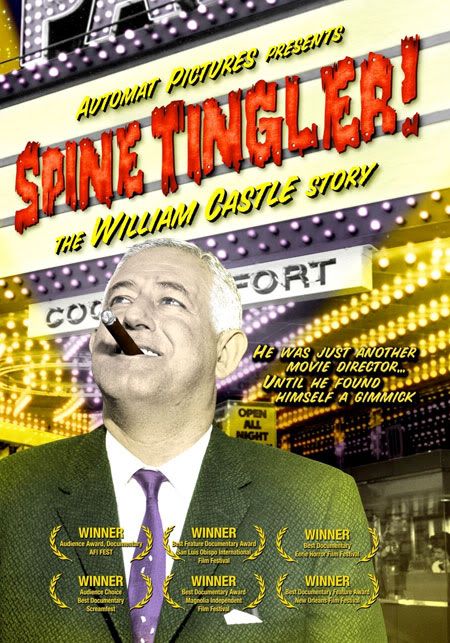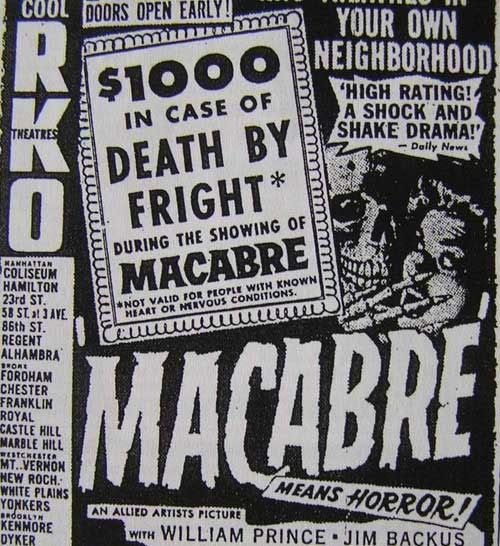 |
| Fig. 1 Spine Tingler! The William Castle Story poster. |
 |
| Fig. William Castle, showman. |
 |
| Fig. William Castle's first gimmick. |
William Castle believed that every film, no matter how popular he was and no matter how likely it was to sell out, should have a gimmick of some kind, something to reward his audience with. Peter Hutchings said that "He was the master of gimmicks during a period when cinema attendance was in decline and showmanship of his kind was required to entice potential customers into film theatres." (Hutchings, 2008:57) His first film was Macabre (1958), a chilling but still family friendly, horror movie and it was released during a time when audiences were still settling in from their difficulties of the forties and paying to get into the cinema to see a B-movie was not their priority. Castle knew this, he knew he had to think of something great to draw them in and he did. He decided that to really draw them in he would use an incentive, a cash incentive to be precise. As seen in Fig. 3, he publicised on TV and to newspapers that anyone that was brave enough to see Macabre would have their life insured for $1000 in case they died from fright. for the time this was something quite unbelievable, and he was there handing out these insurance slips to the audience members as they walked into the theatre. Of course no one actually died of fright, the films were merely entertaining, but his marketing grew and grew because he knew it would keep brining in the viewers. Every film drew in big money at the box office and despite the films being a little far from scary, the gimmicks would make the crowds roar with enjoyment. Hutchings then went on to explain that "William Castle often seemed more interested in the effects his horror films would have on audiences than he was in the content of the films themselves." (Hutchings, 2008:57) Despite the film quality of what was on screen the audience still loved it and always came back for more. Devin Watson continues the point that "we may look back at his films and call them schlock or any other thing we want, but the truth is, he understood and knew his audience."(Watson, 2009:9) which is more than a lot of producers and directors can achieve presently. He just wanted to bring his films and his entertainment to the masses, he wanted it so much that he went out himself and brought his work to the different theatres. He had a fan club just because he was so beloved by everyone for his personal touch and obvious love for what he does. Watson went on to say that "Castle was not only a brilliant filmmaker and television producer, but he was one of the most brilliant marketers who ever worked in the business." (Watson, 2009:9). There are few producers now that would travel around with their work to make sure the audiences enjoyed it. Marketing is key to getting an audience to watch your film and when you get it wrong then no matter how good the film is it will never sell at the box office. It was William Castle's personal touch that made him so popular and his publicity so wonderfully effective. It was a shame that he never got to direct his A-movie, but it is due to his showmanship that his B-movies are never going to be forgotten.
List of Illustrations.
Figure 1. Spine Tingler! The William Castle Story (2007) Spine Tingler! The William Castle Story poster. At: http://www.joblo.com/images_arrownews/spinetinglerdvd.jpg (Accessed on: 13/10/11)
Figure 2. Spine Tingler! The William Castle Story (2007) William Castle, showman. At: http://lewistice.files.wordpress.com/2011/05/4954_sy_wc_about_to_slice_head_touchedupv2.jpg?w=580 (Accessed on: 13/10/11)
Figure 3. William Castle's first gimmick. At: http://www.top10films.co.uk/img/william-castle.jpg (Accessed on: 13/10/11)
Bibliography
Cartmell, Deborah (1997) Trash aesthetics: popular culture and its audience. London: Pluto Press
Heath, Robert Lawrence (2005) Encyclopedia of public relations, Volume 1. USA: Sage Publications, Inc.
Hutchings, Peter (2008) The A to Z of Horror Cinema. USA: Scarecrow Press.
Mathijs, Ernest, Sexton, Jamie (2011) Cult Cinema. Wiley-Blackwell
Watson, Devin (2009) Horror Screenwriting: The Nature of Fear. USA: Michael Wiese Productions.


What no stars? :(
ReplyDeleteNice review though Molly
Sorry Alan! I completely forgot! It'll be up there today! :D
ReplyDelete